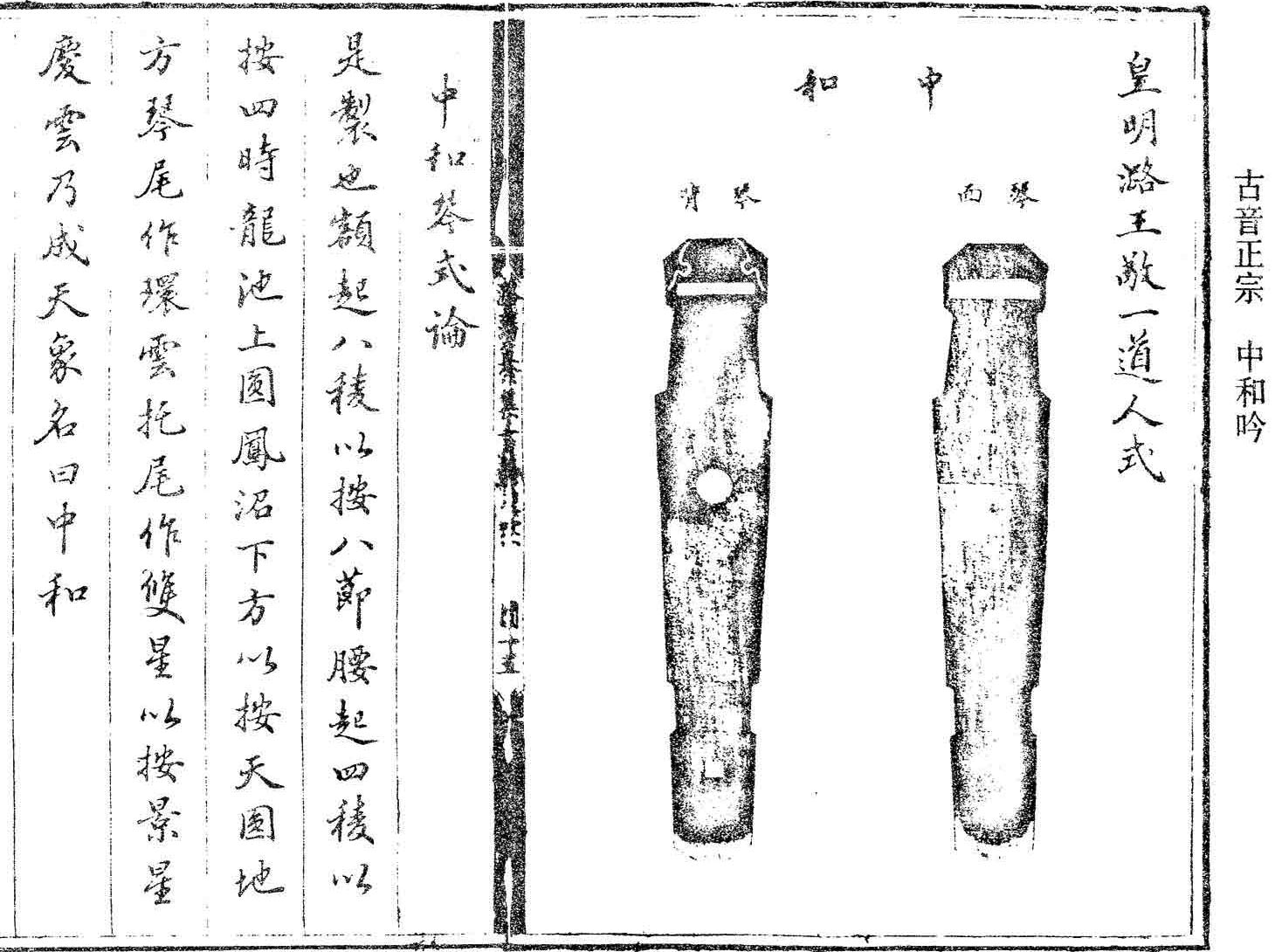|
T of C
Home |
My Work |
Hand- books |
Qin as Object |
Qin in Art |
Poetry / Song |
Hear, Watch |
Play Qin |
Analysis | History |
Ideo- logy |
Miscel- lanea |
More Info |
Personal | email me search me |
| Handbook List Table of Contents / Earliest Yan Luo Pingsha, | 首頁 |
|
Guyin Zhengzong
Orthodox School of Ancient Sounds 1 |
古音正宗
1634 |
| A Luwang "zhonghe" style qin 2 |
 This handbook is one of several to have been compiled by a Ming prince, in this case (Prince) "The honor one-ness Taoist of Lu", Zhu Changfang, also famous for making qins (as at right).3 In 7 folios, it has 50 melodies, 5 with lyrics.
This handbook is one of several to have been compiled by a Ming prince, in this case (Prince) "The honor one-ness Taoist of Lu", Zhu Changfang, also famous for making qins (as at right).3 In 7 folios, it has 50 melodies, 5 with lyrics.
At present I have reconstructed three of the melodies here:
According to Zha Fuxi's introduction to this handbook, prior to its publication it was customary for qin handbooks to add forewords and/or afterwords with each melody, but starting here this was apparently no longer the custom. In fact, only two of the 50 melodies here have commentary.4
Other noteworthy aspects of this handbook include the following:
Furthermore, of its 50 melodies,
at least 14 have their earliest known printing here, with 3 or 4 of them occurring only here.5 Meanwhile, several of the remaining 36 melodies that are not listed here as "earliest" are actually melodically unrelated versions of an older title (for example #50 Guangling San).6
Although as a prince Zhu Changfang apparently had old tablature that might have been copied here, I have not yet found that any of the melodies here has an identical copy in an earlier handbook. Zha Fuxi and other sources also comment on this (see next).
Zha Fuxi's introductory essay in Qinqu Jicheng (IX/2-3) begins as follows:7
This is a very well-appointed volume, the edition itself very large, but judging from the qin music it collected, except for
"Zong Ya Cao" most of it comes from combining a mix of popular score books. One cannot discern the lineage of the versions, perhaps they came from materials selected by palace hangers-on (qingke). From this handbook on, other than the Ming dynasty qin melody titles there is also an end to having individual introductions to each melody. Zhu Changfang's own introduction emphasizes, "People cannot be without music, music cannot be without form. But if there is form but not Dao there cannot but be disorder. So 譜正按形合道之法...."
(Translation incomplete).
Zha Fuxi's comment about not being able to determine the lineage of the melodies in this handbook suggests that none of them are copies from other handbooks, so it is difficult to determine their source. The intriguing question, then, is whether it could also mean that Zhu collected these (or some of these) from people who were actually playing the melodies, rather than from handbooks that perhaps were being kept for reasons of prestige.
In this light it is interesting to speculate as to whether any some of the melodies might have been played by the women
("courtesans") that Zhu is said in this article to have had as constant companions (assistants?).
1.
Orthodox School of Ancient Sounds (古音正宗 Guyin Zhengzong) (QQJC IX/245-386)
2.
"中和:皇明潞王敬一道人式 Zhonghe: Imperial Ming Luwang, the Jingyi Daoist, style" (from QQJC IX/272)
The commentary on the facing page is as follows:
Not yet translated.
3.
朱常淓 Zhu Changfang
4.
Only two melodies with commentary
5.
Melodies newly introduced in the 1534 古音正宗 Guyin Zhengzong
Further details pending.
6.
New melody for older title
7.
Introductory comments in Qinqu Jicheng (IX/2-3)
這是一部裝潢很精,版本最大的刊本,但從它收集的琴曲看,除「宗雅操」而外,多從流行譜本雜湊而
成。看不出它的師承淵源,可能是一些王府清客所選獻的材料。從此譜起,明代琴曲標題之外還有解題的體裁
就中斷了。朱常淓自序強調「人不能無樂,樂不能無形,形而不爲道,不能無亂,則譜正按形合道之法也」,
而廢解題之例卻與此大相矛盾,序中指陳傳統琴曲派品駁雜,「卒未克以地限,以習違」,而他所採的卻是
「可以含天地之弘(原誤刊作私),吸取日月之光……王風股東衆遊其天」,似有狂妄之嫌。
本編用中國藝術研究院音樂研究所藏明潞藩刊本影印,所缺《漁樵問答》及《大雅》以後各曲用上海圖書館藏本補齊。
Above translation incomplete.
Return to the annotated handbook list
or to the Guqin ToC.
Footnotes (Shorthand references are explained on a
separate page)
3308.198...xxx
(Return)
Most of the qins attributed to the
Prince of Lu have the same style as the one in the image above; the style is described on the left side of the page. There are many "Lu Wang qin" still in existence, though apparently there are also many fakes, from the early Qing right up to the present. The particular illustration above comes in the handbook at the end of a list of qin styles. The left image on the right hand page is a view of the bottom; to our right is its top. Above the two qins are the characters 中和, identifying the qin style as Zhong He, a style mentioned in Qinshi Chubian but that is not in the Qin Shapes section of Taiyin Daquanji (compare Confucian"). "皇明潞王敬一道人式", to the right of the instruments, identifies this qin as in the style of the prince's own qins.
是制也,額起八棱,以按八節;腰起四棱,以按四時;龍池上圓,鳳沼下方,以按天圓地方;琴尾作環雲,托尾作雙星,以按景星慶雲,乃成天象,名曰「中和」。
(Return)
For "潞國敬一道人 The honor one-ness Taoist of Lu", 朱常淓 Zhu Changfang, see
separate page.
(Return)
Qiu Hong(copying the preface from Shen Qi Mi Pu) and Mozi Bei Ge (new).
(Return)
Page# links go to their entries in the Guyin Zhengzong
ToC, where there may be further information, or links thereto.
(Return)
Others besides the new Guangling San are not yet identified.
(Return)
The original text is as follows,
(Return)